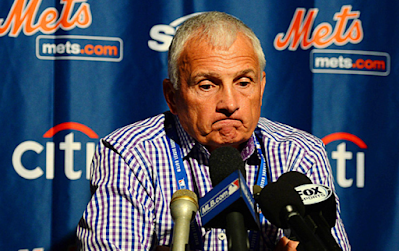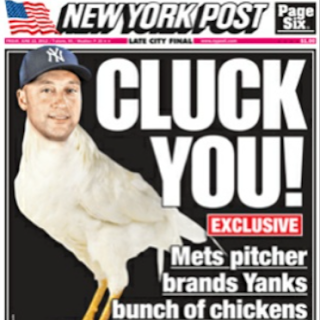In Mike Puma’s If These Walls Could Talk: New York Mets his fourth chapter started off with yet another painful memory. It is focused on later-star Justin Turner who was a valuable bench player for the Mets. He observed that in 2012 the Mets were just a few games out of first place going into the All Star break but were definitely in need of some bullpen reinforcements. Sandy Alderson did not apparently see the need and immediately after the big game the Mets went on a sufferable 1-10 run which took them out of contention.
This period was not that far removed from the 2009 arrest of Bernie Madoff who, at the time, held $500 million of the Wilpons’ money in his pyramid scheme. The club had parted ways with some key players, including Carlos Beltran, K-Rod and Jose Reyes to whom they didn’t even offer a contract when he hit free agency immediately after winning a batting title.
The severity of the forced frugality saw their $140 million payroll almost cut in half which meant they were not going to be in on any of the top free agents or trade for any high-priced players. As a result, they were not a good team. Special Assistant J.P. Ricciardi quipped, “We were like basically like the Statue of Liberty, ‘Give us your tired, your poor, your huddled masses.’ We were scrambling.”
One of the first orders of business for the front office team of Sandy Alderson, J.P. Ricciardi, John Ricco and Paul Depodesta was finding a manager capable of living through the rough times ahead. Interviewed were Wally Backman, Chip Hale, Clint Hurdle and Bob Melvin. Hale would have been a bit of a gamble, but the others held major or minor league managerial gigs and would bring their experience and leadership to the team.
Instead they chose to go after a guy whose previous two gigs in Houston and Anaheim resulted in player revolts and great improvements after he left, Terry Collins. At age 61 he had experience, but the fact remained he had been out of the managerial ranks without a sniff at an offer since being forced out of the Angels locker room in 1999. It would seem when no one wants a guy for a period of over 10 years, it should send a signal to the hiring executives, but the Mets plowed ahead against the tide and brought on the man who would become the losingest manager in team history.
The first big challenge to Collins was the ill-fated decision to sign Jason Bay to play the outfield after turning down Matt Holliday who everyone agreed was a better player but whose agent, Scott Boras, would demand both more money per year and a longer overall contract. By taking the distant second choice due primarily to economics, the Mets obtained Bay with arguably one of the worst free agent contracts ever signed.
Jeff Francouer was and still is a close friend of Jason Bay. He observed that the challenges facing Bay were his health but also the stadium’s dimensions. Said Francouer, “I watched the game the other night and saw Pete Alonso hit his 52nd home run and I watched J.D. Davis hit a home run to right center. Both of those were doubles when we played here in the old Citi Field. I think about all the balls I hit that got caught at the warning track or hit doubles off the wall. They are home runs now.”
After the two concussions he suffered there was no turning back the clock. R.A. Dickey was his teammate and observed, “He worked his butt off, there was no lack of commitment, lack of work. He was a pro, too, after all that crap. I know everybody under the sun tried to identify what was going on offensively with him. He was always a great defender, even when he was struggling offensively.”
During Collins’ era with the Mets they dumped Carlos Beltran to save money and obtained prospect Zack Wheeler in return. Alderson observed that typically rentals don’t net a team top young talent but the feeling was the Mets needed to save money and there was concern over the condition of his knees. Of course, Beltran went on to play another six seasons during which he hit 133 HRs and drove in 441. He was obviously not done yet. Wheeler did become a solid pitcher but not so much that the Mets made any attempt to keep him before he fled for the big bucks offered in Philadelphia.
It was also during this period that the Mets got rid of Frankie Rodriguez. The public story was that the team was dissatisfied with his professionalism after the fight that took place the year before, but if that was the reason they would have parted ways back then. Instead, it was his contract that paid a lot of money and was poised to kick in to secure another year based upon incentives, so he was essentially given away to Milwaukee for non-prospects Danny Herrera and Adrian Rosario, neither of whom made any impact for the Mets major league team. After a short trial the year he was acquired, Herrera’s injuries took him out of baseball. Rosario never even made it above AA.
The dysfunctionality of the clubhouse was illustrated by another Francouer tale of a period when Carlos Beltran was rehabbing from injury. Apparently Beltran loves to cook and during his time off the active roster brought a stunning tres leches cake into the locker room after a victory. Jeff Wilpon was present and commented, “I am glad we are paying you $18 million to bake a fucking cake!”
Puma did a stellar job going through the history of the R.A. Dickey signing, his stellar performance for the Mets and his highly unexpected pursuit of the Cy Young Award. It ended, of course, with the trade to Toronto mostly because as a pending free agent he was due for a huge bump in salary which the Mets could not afford with the David Wright contract being a part of their long term foundational legacy. He understood and the Mets sent him north with catchers Josh Thole and Mike Nickeas to obtain Travis d’Arnaud, John Buck, prospect Wuilmer Becerra and a tall, blonde right handed pitcher with very long hair named Noah Syndergaard.
Puma then recalls the story of ill-fated reliever Frank Francisco who spent more time disabled than pitching for the Mets (but given his lackluster production, that result was not necessarily a bad thing). In his two years combined he went 2-3 with a 5.36 ERA and just 24 saves. Walks were always a problem and he gave up more hits than innings pitched.
The story of calling the Yankees chickens had a huge in-clubhouse impact with nasty comments from the Yankees on the bulletin board as well as Mets players Justin Turner blasting “The Chicken Dance” at high volume on his iPod and reliever Tim Byrdak bringing a live chicken he dubbed, “Little Jerry Seinfield” into the clubhouse to tease Francisco after the newspaper headline read, “Cluck You!”
There were tales of the arrival of elder reliever LaTroy Hawkins who performed quite well during his short stint with the Mets as well as the arrival of hot prospect Matt Harvey. It became quite clear that Harvey was more interested in his own personal celebrity status than he was in how he performed on the field. A series of injuries led to his eventual early release and he’s fought to try comebacks with several teams. This year he’s in Baltimore, but other than the one good game against the Yankees, he’s not been the Dark Knight.
One of the more aggravating tales in this chapter concerned the role of Justin Turner, how he was obtained, what he did while he was here and the unceremonious way he was dumped from the roster. In particular one thing stood out far more than the pies to the face. One Spring Training Turner arrived in Florida at his own expense well ahead of schedule and began working out early with no pay from the Mets. He happened to wear a Mets shirt in orange while everyone else was in blue but Jeff Wilpon wasn’t happy about that. Turner commented, “You’re not paying me to be here, I am going to wear what I want to wear. As soon as I’m supposed to be here, on your dime, I will wear whatever you want me to.” Needless to say, Turner was cut from the roster after a season in which the then 28 year old had hit .280.
The chapter continues with the tale of the arrival of then mixed prospect Jacob deGrom who was brought in to be a reliever. An unfortunate injury to Dillon Gee opened up a spot in the rotation and Collins asked deGrom if he could make a spot start. That Wally Pipp opening resulted in a first year record of 9-6 with a 2.69 ERA and the Rookie of the Year Award. That was, of course, followed by back-to-back Cy Young Awards later in his career and people marvel that he’s throwing harder and more effectively now than when he took the NL honors for his rookie season in 2014. For comparison’s sake, his current ERA is just 0.51 (as of 4/30) and he has been fanning 15.2 per 9 IP while giving up just a single walk. Wow!





4 comments:
Don't get me started on not keeping Justin Turner and on the original Wilpon Citi Cavern.
Francouer hit 2 bullets to right center in one of the first games he played at Citi - right towards the 415 sign. Both would be HRs now. Both were caught on the track. Those fence depths were the most asinine thing I ever saw.
I forgot how Jake became a Mets starter.
Weren't the outfield dimensions for Reyes so they could watch him run out triples or was that just a rumor? Also it killed D. Wright as it took his right center power alley away. I lost track of how many HR's he lost.
Sad to minimize the impact Harvey had. Before he was injured, he was one of the top pitchers in baseball.
Post a Comment